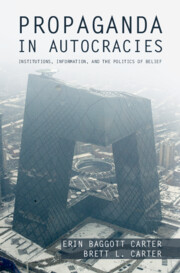Book contents
- Frontmatter
- Dedication
- Epigraph
- Contents
- Figures
- Tables
- Acknowledgments
- Part I Foundations
- 1 Persuasion and Domination
- 2 A Theory of Autocratic Propaganda
- 3 A Global Dataset of Autocratic Propaganda
- Part II The Political Origins of Propaganda Strategies
- 4 The Politics of Pro-regime Propaganda
- 5 Narrating the Domestic
- 6 Narrating the World
- 7 Threatening Citizens with Repression
- Part III The Propaganda Calendar
- 8 The Propagandist’s Dilemma
- 9 Memory and Forgetting
- Part IV Propaganda, Protest, and the Future
- 10 Propaganda and Protest
- 11 Conclusion
- References
- Index
- Other books in the series
10 - Propaganda and Protest
Published online by Cambridge University Press: 18 July 2023
- Frontmatter
- Dedication
- Epigraph
- Contents
- Figures
- Tables
- Acknowledgments
- Part I Foundations
- 1 Persuasion and Domination
- 2 A Theory of Autocratic Propaganda
- 3 A Global Dataset of Autocratic Propaganda
- Part II The Political Origins of Propaganda Strategies
- 4 The Politics of Pro-regime Propaganda
- 5 Narrating the Domestic
- 6 Narrating the World
- 7 Threatening Citizens with Repression
- Part III The Propaganda Calendar
- 8 The Propagandist’s Dilemma
- 9 Memory and Forgetting
- Part IV Propaganda, Protest, and the Future
- 10 Propaganda and Protest
- 11 Conclusion
- References
- Index
- Other books in the series
Summary
Does propaganda discourage the sorts of protests that increasingly constitute the chief threat to autocratic survival? Answering this question is complicated by the fact that propaganda is strategic. The regimes that employ more pro-regime propaganda and threaten citizens with violence are systematically different than those that do not. Using a range of estimation strategies, we show that spikes in pro-regime propaganda across autocracies are associated with a 10 percent reduction in the odds of protest the following day. The half-life of the effect is between two and five days, a temporal signature that is strikingly consistent with political messaging in American politics. In China, using an instrumental variables estimation strategy, we show that by doubling the number of references to “stability” or “harmony” – widely acknowledged as codewords for threats of repression – the CCP’s propaganda apparatus halves the number of protests over the subsequent week. These estimates, we show, are robust to non-trivial violations of the exclusion restriction.
Keywords
- Type
- Chapter
- Information
- Propaganda in AutocraciesInstitutions, Information, and the Politics of Belief, pp. 413 - 442Publisher: Cambridge University PressPrint publication year: 2023

